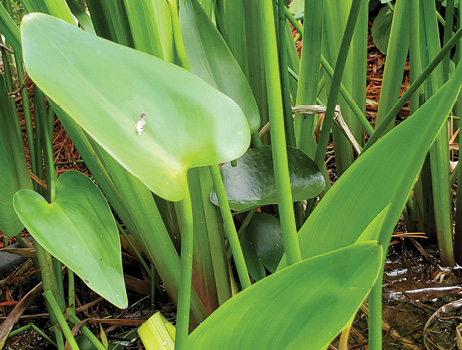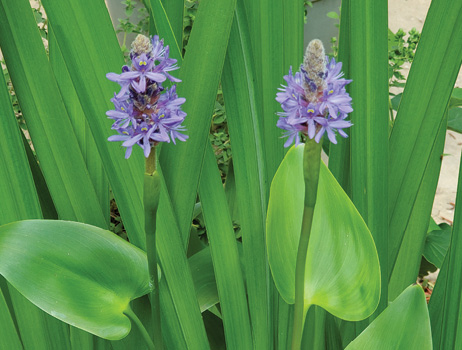Pickerelweed | Pontederia cordata
Emergent | Native



Pickerelweed is an emergent aquatic plant that grows in shallow, calm water. Plants can reach 3 feet in height, and have glossy green, heart- or sword-shaped leaves with parallel veins on spongy stems.
The flowers are very attractive and resemble hyacinth. Blooming occurs all summer and produces a flower spike with blue, white, and violet flowers that rises above the leaves with a single leaf attached to the flower stalk.
Management Value
Many species eat or use pickerelweed in natural systems. Deer enjoy the tender plant, waterfowl eat the seeds, butterflies and bees use the pollen, and dragonflies use plants as a hunting perch. Muskrats eat the rhizomes and base. It creates shallow water structure for fish and aquatic insects. In fact, it is named pickerelweed because pickerel are known to ambush prey from between the plants.
Humans use pickerelweed for more than aesthetics. The starchy seed can be eaten fresh or dried like nuts and added to granola or cereal, or can be boiled, roasted, or ground into flour. The young leaves can be eaten raw in salads or sauteed in butter, and the stalks are often cooked and served as a green vegetable.
Pickerelweed is a beautiful plant that spreads slowly and rarely causes problems in ponds. It is recommended for habitat enhancement and can be planted directly in shallow water or placed around the pond in pots.
Recommended Controls
Option 1: Glyphosate (5.4-pound formulation). For each gallon of water, mix 1.0 ounce glyphosate and 1.3 ounces non-ionic surfactant. Spray to wet all exposed plants. Do not exceed annual herbicide rate limits as stated on the product label.
Option 2: Imazamox (1.0-pound formulation). Imazamox (52 ounces per acre-foot of water) should be applied as a submersed injection (application using a wand or hose). Do not exceed annual herbicide rate limits as stated on the product label.
NOTE: Acre-foot = average depth of pond multiplied by pond acreage; average depth is calculated by taking the depth at 20 points across a water body and averaging the values.
For submersed injections, the best approach is to treat ponds with herbicides when water temperature is at least 60˚F.
Submersed injection means that the herbicide solution should be applied below the water surface directly into the water.
Read and follow all chemical label instructions, especially the section on the use of personal protection equipment.

The information given here is for educational purposes only. References to commercial products, trade names, or suppliers are made with the understanding that no endorsement is implied and that no discrimination against other products or suppliers is intended.
Publication 3735-31 (POD-11-23)
By Wes Neal, PhD, Extension/Research Professor, Wildlife, Fisheries, and Aquaculture; Dennis Riecke, Fisheries Coordinator, Mississippi Department of Wildlife, Fisheries, and Parks; and Gray Turnage, PhD, Assistant Research/Extension Professor, GeoSystems Research Institute.
The Mississippi State University Extension Service is working to ensure all web content is accessible to all users. If you need assistance accessing any of our content, please email the webteam or call 662-325-2262.



